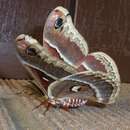en
names in breadcrumbs


Hyalophora gloveri is a large moth with a wingspan of about 10 cm. They have reddish-brown and grey forewings marked with a small eyespot, thick white bands, and white discal spots. Hyalophora gloveri possess large, quadripectinate (elaborate, featherlike) antennae on the tops of their heads. They have a large abdomen, striped white and rufous (reddish-brown). The head and thorax are rufous as well, with a white collar on the thorax to divide the two. The rufous color extends across the proximal and median areas of their forewings. There are obvious thick white antemedial and postmedial bands, both bordered by black on the sides within the median area. The moth also has a small, ovaline discal spot located on the median part of its forewing that is cream and orange with a black border; as well as a large crescent shaped one on the hindwing. The subterminal part of their wings is a light, powdery grey, containing a small black and blue eyespot that is located on the apex (top outer corner) of their forewing. A slight blushing of pink and purple is found right above this. The subterminal line is a scalloped, cream-colored edge that looks not unlike aged lace. The wing margins (outer edge) are bordered by a cream-colored line.
Adult Hyalophora gloveri moths emerge in the pre-dawn hours of late May to early June (Roberts, et al. 2014), the males emerging a few days before the females (Tuskes, et al. 1996). The adults have atrophied mouthparts but are able to sustain themselves for 6-7 days on the energy they created as voracious caterpillars. The females release pheromones which the males are able to detect over great distances thanks to sensilla (hair-like sensory structures) on their large antennae. The females are usually found and mated on their first night of emergence and begin laying eggs (ovipositing) on their preferred host plant. They lay the bulk of their eggs on the first night they mate, but will lay more on subsequent nights as well. Females have a large abdomen, containing on average 155 eggs (Miller, 1978); about 103 of which will hatch within two weeks of being laid (Miller, 1978), ready to start the cycle again.
Hyalophora gloveri, or Glover's silkmoth, is a moth of the family Saturniidae. The species was first described by Ferdinand Heinrich Hermann Strecker in 1872. It is found in the Rocky Mountain states, the western parts of the northern Great Plains, and the Canadian prairie provinces, north-west to at least central Alberta. It is also found in northern Mexico.
It is considered a subspecies of Hyalophora columbia by several authorities.
The wingspan is about 100 mm.
The larvae feed on Shepherdia argentea, Elaeagnus angustifolia, Salix species, etc.
Hyalophora gloveri, or Glover's silkmoth, is a moth of the family Saturniidae. The species was first described by Ferdinand Heinrich Hermann Strecker in 1872. It is found in the Rocky Mountain states, the western parts of the northern Great Plains, and the Canadian prairie provinces, north-west to at least central Alberta. It is also found in northern Mexico.
It is considered a subspecies of Hyalophora columbia by several authorities.
The wingspan is about 100 mm.
The larvae feed on Shepherdia argentea, Elaeagnus angustifolia, Salix species, etc.
Hyalophora gloveri er en sommerfugl som hører til familien påfuglspinnere (Saturniidae).
En temmelig stor (vingespenn ca. 100 millimeter) påfuglspinner med store, lange vinger. Forvingene er ikke eller ubetydelig sigdformede. Grunnfargen er gråbrun til rødbrun, den ytre delen er lysere. Hver vinge har en mer eller mindre halvmåneformet, lys flekk og en hvit tverrstripe utenfor denne. Spissen av forvingen har en liten øyeflekk.
Larvene lever på ulike slags busker og trær. Disse artene kan utnytte en rekke forskjellige fødeplanter. De voksne sommerfuglene tar ikke næring til seg, men overlever på fett de har lagret fra larvetiden. De store hunnene sitter mest i ro og sender ut feromoner, som de aktive hannene kan merke på lang avstand. Denne arten lever i tørre dalstrøk mellom fjellene.
Arten er utbredt i det vestlige Nord-Amerika nord til Alberta, sør til det nordlige Mexico.
Arten blir ofte regnet som en underart av Hyalophora columbia.
Hyalophora gloveri er en sommerfugl som hører til familien påfuglspinnere (Saturniidae).
Hyalophora gloveri este o specie de molie din familia Saturniidae. Este răspândită în Munții Stâncoși și în unele zone din Canada, dar poate fi întâlnită și în nordul Mexicului.
Este câteodată considerată o subspecie a Hyalophora columbia.
Are o anvergură de aproximativ 100 mm.
Larvele au ca principală sursă de hrană Shepherdia argentea, Elaeagnus angustifolia, specii de Salix, etc.
![]() Materiale media legate de Hyalophora gloveri la Wikimedia Commons
Materiale media legate de Hyalophora gloveri la Wikimedia Commons
Hyalophora gloveri este o specie de molie din familia Saturniidae. Este răspândită în Munții Stâncoși și în unele zone din Canada, dar poate fi întâlnită și în nordul Mexicului.
Hyalophora gloveri là một loài bướm đêm thuộc họ Saturniidae. Nó được tìm thấy ở các bang vùng dãy núi Rocky, phần phía tây của miền bắc Đại Đồng Bằng, và các tỉnh vùng đồng cỏ Canada, kéo dài về phía tây bắc ít nhất là tới miền trung Alberta. Nó cũng được tìm thấy ở miền bắc México.
Trước đây nó đã được coi là một phân loài của Hyalophora columbia. Sải cánh dài khoảng 100 mm. Ấu trùng ăn Shepherdia argentea và Elaeagnus angustifolia.
Phương tiện liên quan tới Hyalophora gloveri tại Wikimedia Commons
Hyalophora gloveri là một loài bướm đêm thuộc họ Saturniidae. Nó được tìm thấy ở các bang vùng dãy núi Rocky, phần phía tây của miền bắc Đại Đồng Bằng, và các tỉnh vùng đồng cỏ Canada, kéo dài về phía tây bắc ít nhất là tới miền trung Alberta. Nó cũng được tìm thấy ở miền bắc México.
Trước đây nó đã được coi là một phân loài của Hyalophora columbia. Sải cánh dài khoảng 100 mm. Ấu trùng ăn Shepherdia argentea và Elaeagnus angustifolia.